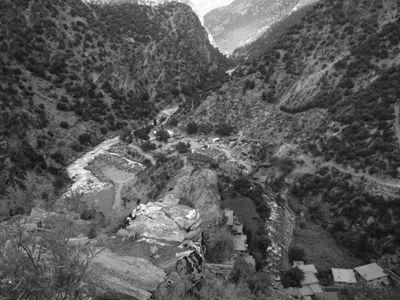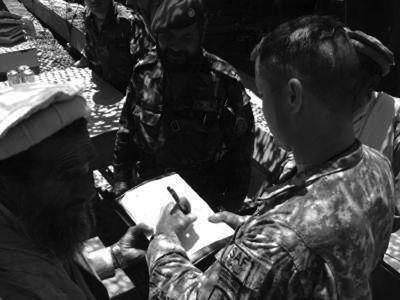The Outpost: An Untold Story of American Valor (51 page)
Read The Outpost: An Untold Story of American Valor Online
Authors: Jake Tapper
Tags: #Terrorism, #Political Science, #Azizex666

With his leadership now more encouraging of his efforts, and violence nearly nonexistent in his area, Kolenda figured that things were about as good as they could get. The situation remained fragile, he knew. There wasn’t any question that some of those being brought into the confidence of the Hundred-Man Shura were allied or associated with “bad HIG.” But Kolenda, ever the optimist, believed this was part of a deliberate effort, by Abdul Rahman and other key shura leaders, to “turn” some of these more nefarious characters and thereby gain greater credibility with the enemy, with the ultimate goal being a laying down of arms. Others in Bulldog Troop were more skeptical, thinking the Hundred-Man Shura members were hedging their bets by supporting both sides.
In May, a number of shura leaders came to Camp Keating to meet with Hutto, Kolenda, and Governor Nuristani. The elders were irate about what they viewed as the empty promises made by President Karzai. He had told them the government would provide funding for the Hundred-Man Shura and local police, but so far, he’d given them nothing. Bulldog Troop covered their food and transportation costs for specific meetings, but the elders also needed money for other trips and internal meetings.
Kolenda doubted that the Afghan president would ever deliver, despite the billions of dollars the United States had supplied to his government. His administration was born vulnerable and then atrophied in its crib. As even Karzai himself had admitted in 2007, “the Taliban are not strong. It is not them that cause the trouble. It is our weakness that is causing trouble.”
42
Kolenda wasn’t willing to let all his hard work, all this promise, vanish because of Karzai’s incompetence and corruption.
So he didn’t let it happen. He pledged to the elders that 1-91 Cav would provide them with funding until the Afghan government ponied up. The leadership of the 173rd Airborne had earlier approved Kolenda’s request for a “governance fund” to pay expenses incurred by shura members in connection with their official activities, but he’d been waiting to tell the elders about it until he felt they’d proven themselves to him. The signed documents from Mohammed Jan, the decreasing levels of violence, the absence of illegal checkpoints on the road, the significant decline in the price of local goods due to improved security, and the shura’s frequent interaction with people in the villages, with 1-91 Cav, and with Afghan forces—all of these things told Kolenda that the Hundred-Man Shura was showing itself to be a viable partner.

A view of Combat Outpost Keating from the northwestern mountain.
(Photo courtesy of Dave Roller)

Lieutenant Colonel Chris Kolenda tells the Hundred-Man Shura that 1-91 Cav will enter into an agreement with them.
(Photo courtesy of Bulldog Troop)
After lunch, Kolenda and Hutto changed into Afghan clothing that the elders had given them. When they returned, the elders cheered. A voice in English cried out, “You are a good guest. You are a good guest!”
Kolenda looked up, stunned to hear a Kamdesh elder speaking English. Aktar Mohammed, from Mandigal, now moved closer to Kolenda and, with perfect diction, expressed his appreciation for the respect the Americans showed the Nuristanis, as well as their support of the people. Hutto and Kolenda, he announced, were to be made honorary citizens of Kamdesh. The elders had already given Hutto the name Abdul Wali, meaning “servant of the governor,” and now they bestowed upon Kolenda the name Ahmad, “highly praised one”.

Kolenda signs the Commitment of Mutual Support.
(Photo courtesy of Bulldog Troop)
That evening, in Kamdesh Village, there was a celebration. It was a night that would mark the high point of the Americans’ relationship with the people of Kamdesh.
The troops continued to remain vigilant, but the calm meant that they could take some time to enjoy life. They held rib and chili cookoffs. One soldier was put in charge of camp beautification. Flower gardens and a vegetable garden were cultivated. The outpost’s roofs were made completely waterproof, and the full-service showers operational. Walls were covered with every color of paint the men could get their hands on. A new gym was constructed, and ground broken for a new, air-conditioned dining hall.

Lieutenant Colonel Kolenda makes his entrance in Afghan garb.
(Photo courtesy of Bulldog Troop)
And then the enemy adjusted his tactics.
In May, insurgents in Lower Kamdesh fired a few large-caliber rounds at Combat Outpost Keating—the first attack with a large-caliber weapon in that area since the July 27, 2007, ambush at Saret Koleh, almost a year before. Perhaps the most ominous aspect of the action was the specific weapon used. At first, the men of Bulldog Troop couldn’t place it—the explosions were louder than the usual insurgent 7.62-millimeter fire from an AK machine gun, though not as loud as RPG blasts—but then they realized what it was: an immense Dushka machine gun, of the type last seen during the Saret Koleh ambush in the spring of 2007 and, before that, in the Chowkay Valley in 2006. This suggested outside help, likely from Pakistan.
Over the course of a week, there would be one or two Dushka rounds fired, and the shooters seemed to know what they were doing. Bracketing is a process whereby shooters shoot a round over a target, then a round short of it, then keep calibrating back and forth until they have an exact fix on the spot they want to destroy. In this case, the insurgents, over several days, were bracketing the landing zone at Combat Outpost Keating, presumably so they could take out the next chopper that came in.
Shortly after the first Dushka shot, Hutto demanded that the Kamdesh elders come down to Camp Keating. When they arrived a few hours later, he was furious. How could a heavy weapon like a Dushka be in Lower Kamdesh without their knowing about it? It was, he snapped, unacceptable.
Just then, as if to punctuate Hutto’s point, a large-caliber round from the Dushka struck a sandbag near the elders.
Abdul Rahman promised he would take care of it.
After the elders returned to the village, the Dushka fire stopped. Rahman later told Hutto that the gun was no longer in Lower Kamdesh. But it soon became clear enough that the Dushka, and the insurgents firing it, were still around and active; they’d just moved out of Kamdesh Village proper. Hutto was not satisfied, and he let Rahman and the other elders know it. A few days later, a soldier at Observation Post Fritsche spotted an insurgent dragging the Dushka up a mountain west of Agasi. After further reconnaissance, Roller radioed it in, and a five-hundred-pound bomb found its way onto the enemy’s head. No more Dushka.
But then came the mortars.
CHAPTER 20
T
he mortar round whistled through the air and landed a few hundred yards away from 3rd Platoon. The men had just left Combat Outpost Keating on a patrol. Newsom had been taught in Ranger school that the worst thing to do during a mortar attack was to stay in one place, so they ran and found cover.
“Hey Bulldog-Six, this is Three-Six,” he radioed to Hutto. “We’re taking mortar fire.”
“
What?”
Hutto asked. He couldn’t believe it: the insurgents had now gotten their hands on mortars, which were capable of firing immense rounds from a considerable distance, even out of the line of sight. This was no small thing; in fact, it was a potentially lethal development. After some crater analysis, Newsom’s men determined that the mortar had come from the north and was a white-phosphorous smoke round, very accurately fired.
Hutto reached out to the Hundred-Man Shura, whose members expressed concern as well. They said they didn’t know where the mortars were coming from, and they swore the insurgents were not Nuristanis—a claim backed up by the fact that the enemy chatter the Americans had started picking up was in Urdu.
More mortar attacks followed, professional assaults launched from unknown locations but generally consisting of just a few rounds. New intelligence suggested that several mortars were now in the hands of insurgents throughout Nuristan and Kunar Provinces, and that the enemy had brought in a Pakistani mortarman to train the local talent how to use 82-millimeter Soviet-style weapons. Whenever the rounds came in, Hutto and his men would fire back, but the mortars were coming from too far away to let them pinpoint their target, and the enemy fighters were constantly moving around. This was not good at all.
One possible location for the enemy mortar tube, intelligence officers believed, was the mountains to the north, on the way toward Mandigal. But where, exactly?
Since joining 1-91 Cav the previous summer, Lieutenant Kyle Marcum had been frustrated by the limited number of paths the troops used on their patrols from Camp Keating. He was sure there were other routes on the mountains that they hadn’t yet discovered. Marcum and Newsom now decided to start blazing a new trail north to Mandigal, figuring that sooner or later they would find an existing path that would allow them to sneak into the area and possibly observe the enemy mortar crew at work.
As a first step, Newsom and 3rd Platoon set up an overwatch while about eight guys from 2nd Platoon bushwhacked until they stumbled—as Marcum had suspected they might—upon a substantial trail running all the way north to Mandigal. Encouraged, Marcum, Newsom, and more than a dozen other troops left Camp Keating on the night of June 14, hiked undetected up the newly discovered path, camped out, and waited for the enemy mortar crew to show itself. They’d been in their position for roughly two hours, camped in the dark mountains, when, around midnight, Newsom spotted something through his night-vision goggles. “Am I crazy,” he asked Marcum, “or do you see a light moving way up on the mountain over there?”
